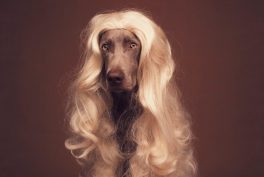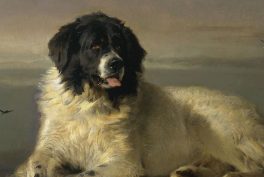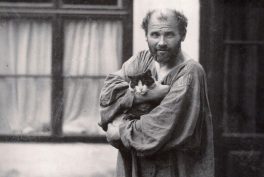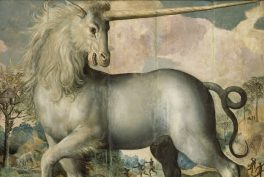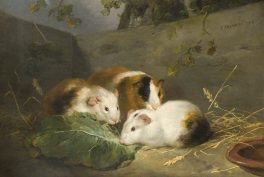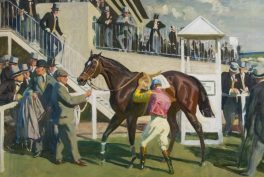1. A Surrealist Love: René Magritte and His Pomeranians
René Magritte was one of the most prominent figures of Surrealism. Although we all know his paintings, few are aware that he owned four-legged companions that shared his home, heart, and studio. He loved Pomeranian dogs and owned four of them—two named Loulou and two Jackies. In 1965, the artist planned to make his first and only trip to the United States as the Museum of Modern Art in New York was organizing his retrospective. However, Magritte worried about whether his beloved dog would be allowed on the plane or in American hotels. Eventually, he was able to take his beloved Loulou with him, and the story shows how much he cared for his companions.
Years earlier, Magritte created a piece titled Le Civilisateur. In the painting, he portrayed his third Pomeranian, Jackie, in an aura of wisdom—the painting’s classical architecture emphasizes that regal presence and adds a deeply philosophical calmness. Le Civilisateur is much more than a traditional painting. It carries the subtle Impressionistic touch that Magritte introduced during his solar period.
2. Jackson Pollock and His Healers: Gyp and Ahab
Jackson Pollock ranks among the most influential American painters. He led the Abstract Expressionism movement, gaining significant recognition for his innovative dripping technique. Although he lived an isolated life, he displayed a volatile personality and battled severe alcoholism throughout his career. These personal struggles accompanied him until the end of his life.
At the time this photograph was taken, Pollock was collaborating with a commercial gallery. The demands on his art from the collectors put even greater pressure on him, deepening his alcoholism. Yet, in this particular image with his two dogs, Gyp and Ahab, he appears calm and possibly at peace. The moment illustrates how the connection with our dogs can help us get through the worst periods of our lives. Indeed, Gyp and Ahab left their mark on the artist since their paw prints still adorn the door of Pollock’s studio.
3. The Guardian Spirits of Frida Kahlo
In her paintings and daily life, Frida Kahlo consistently embraced the pre-Hispanic image of Xólotl, a dog-shaped god and a symbol of Mictlān (the underworld). She even named her beloved dog, Señor Xólotl, after him and depicted it in her famous The Love Embrace of the Universe, the Earth (Mexico), Myself, Diego and Señor Xólotl, exhibited in 1949. By then, she had fully embraced her now-famous nationalist style.
Various photographs and testimonies preserved in Casa Azul (Frida Kahlo´s Museum) highlight her Xoloitzcuintle dogs—a breed which, according to ancient stories, was created by Xólotl. Indeed, they can often be seen strolling through courtyards or keeping her company at the studio.
Kahlo recognized the significance of these dogs, particularly because they represented Aztec culture and were nearly extinct. She spearheaded the breed’s rescue efforts and reintroduced it to Mexican society as part of a broader pre-Hispanic legacy. Consequently, her canine companions appear subtly in some of her paintings, reflecting her deep affection and the symbolic value she assigned to them.
4. Adamo Boari and His Setter Aída
After Italian architect Adamo Boari arrived in Mexico City, he was entrusted with one of his most ambitious projects—the creation of the Palacio de Bellas Artes. However, he wasn’t alone in this monumental task. His loyal setter, Aída, was by his side every step of the way, earning the admiration and affection of all who witnessed her presence during construction.
Sadly, Aida passed away before Boari’s grand work was completed. Devastated, the architect decided to immortalize his beloved companion by incorporating her likeness into the façade, with the help of his fellow countryman, Beno Gianetti Fiorenzo. Over the years, this act of love has captured the hearts of thousands of people in the city, forever linking Aída’s memory to the grandeur of the Palace.
5. A Very Pop Dog: Archie, Andy Warhol’s Dachshund
Early on, Andy Warhol was a cat enthusiast, but following a suggestion from his friend Jed Johnson, he decided to adopt a dog. That’s when a short-haired Dachshund puppy named Archie entered his life. From that moment, Warhol and Archie were inseparable. Warhol took Archie to his studio, gallery openings, and even to restaurants. Archie, in turn, would often hide in Warhol’s lap, enjoying whatever bits of food the artist offered. In interviews, when confronted with questions he preferred not to answer, Warhol would steer the conversation away and playfully turn to his little dog, Archie.
As Archie neared three years old, another Dachshund joined the family. Warhol dubbed the new pup Amos. Together, they formed a tight-knit trio, sharing countless moments of laughter and joy. When Warhol went on tour, Archie and Amos stayed home, keeping each other company. In 1976, Peter Brant, an art collector, asked Warhol to paint his Cocker Spaniel, named Ginger. This commission paved the way for a new series of portraits featuring Warhol’s beloved dogs, Archie and Amos.
6. Chow Chows: Georgia O’Keeffe’s Gentle Companions
Georgia O’Keeffe is celebrated as one of the 20th century’s most influential American artists. She’s particularly famous for her large-scale flower paintings and Southwestern US landscapes. Less discussed but equally important in her personal life was her deep connection with her dogs of the chow chow breed. These loyal companions shared her life in New York and were especially present during her retirement years in New Mexico.
O’Keeffe quickly formed a bond with this breed, known for its independence, bluish tongue, and thick fur. It’s believed that she first adopted chow chows during the late 1920s or early 1930s. In the 1940s, she moved to New Mexico, where the desert landscape inspired much of her work. Her dogs were not just pets but protectors in this more isolated environment. O’Keeffe and the chow chow breed share a reputation for strong, independent personalities.
The artist was a pioneering woman in a male-dominated art world and was known for embracing solitude. Similarly, chow chows tend to be reserved around strangers but are intensely loyal to their owners, making them an ideal match for O’Keeffe’s need for privacy.
7. Pluto and Eli: Lucian Freud’s Whippets
Lucian Freud was a British painter who gained renown for his intense portraits and distinctive brushwork, which created skin-like textures. Throughout his life, he nurtured a deep appreciation for animals, especially dogs, and featured them repeatedly in his art. Particularly, he loved whippets, with Pluto and Eli being among his favorites.
Pluto entered Freud’s life in the late 1980s, although no one knows if the dog officially belonged to him. Freud often cared for his friends’ or assistant’s dogs, yet he kept Pluto close for many years. This whippet spent countless hours in Freud’s Holland Park studio and other London workspaces, serving as a trusted companion during long painting sessions. Double Portrait (1985–1986) is one of Freud’s most famous works featuring Pluto. In this painting, Pluto poses with Freud’s daughter, Bella, illustrating the intimate bond he fostered with his models.
Meanwhile, Eli appeared in the artist’s life during the late 1990s. By this time, Freud had solidified his reputation with the help of his assistant, David Dawson, who was the one gifting the dog to the artist. Eli modeled for a couple of paintings, including the last, unfinished one. Freud carefully studied the anatomy of his dogs and the subtle tones of their fur, mirroring his approach to the realistic depiction of human skin. His dense brushstrokes captured each dog’s unique character, creating almost psychological portraits.
David Douglas Duncan, a renowned photojournalist, was Pablo Picasso’s close friend and the owner of Lump. Duncan photographed the artist many times at Villa La Californie in Cannes, France. In 1957, Duncan visited Picasso there once again, bringing along Lump. The dachshund quickly formed a bond with the artist, which led to a lasting companionship. Picasso had many dogs during his lifetime, but Lump held a particularly special place.
The artist is said to have shown a deep affection for the dog. It is reported that Lump was allowed to roam freely around Picasso’s house and even shared meals with him. Over time, Lump became a legendary figure in art history. Thanks mainly to Duncan’s photography and the dog’s frequent appearances in Picasso’s works, Lump became nearly as famous as the artist himself.
Lump lived with Picasso for six years, until 1964, when the dog required medical treatment. After a period of recovery, he returned to live with Duncan. Lump passed away in 1973, just days before Picasso’s death. This coincidence is often seen as symbolic, offering a fitting end to the close bond the two shared.

